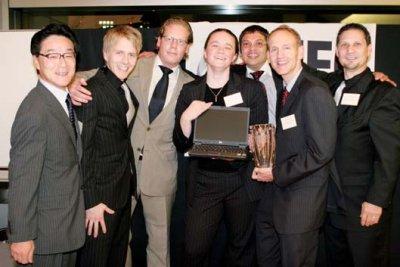Fresh Approach
Bringing a new set of eyes to companies looking to improve their business in Japan
By Beckie Cassidy
Developing a viable business plan for the Japanese market can be a daunting task for foreign companies unfamiliar with the local market and culture. With a set of challenges specific to the nation, incorrect assumptions can prove disastrous. While businesses work to develop their own plans, they often remain oblivious to fresh and innovative strategies that students at business schools are developing, possibly even for their own companies.
 Parasolmedia displays its parasols at Decks in Odaiba during Golden Week 2008
Parasolmedia displays its parasols at Decks in Odaiba during Golden Week 2008
Now in its 15th year, The Japan Market Expansion Competition (JMEC) aims to give client companies an alternate strategy to entering the market or expanding their trade in Japan. It is a program that, while based on a similar premise to the business school contests, allows participants to work with real companies to write real business plans that can be implemented upon completion of the program each June.
JMEC participants begin in November by taking part in a lecture series covering the basics of business as well as the challenges faced by start-ups and multinational companies working in Japan. Once the lecture series is complete, participants are placed into teams and are assigned to one of the companies taking part in the program. Under the guidance of a mentor and a consultant, teams then work with the project client (company) to write a business plan addressing the specific challenges the company is facing in Japan. Because every project client is different, each team faces a unique set of challenges and so needs a business plan tailored to their needs.
One company that took part in JMEC 2006-2007 was SKW East Asia, a German firm that was established in Japan in 1986. While its main business presently focuses on the importation of food products and consultation with food manufacturers, it traditionally imported metallurgical products such as natural graphite and aluminum panels. The company had recently added a line of giant parasols to its portfolio. While the parasols have proven very popular in Europe, initial attempts to introduce them to the Japanese market did not meet with the same success.
Japan offers its own set of unique business challenges. In the case of SKW East Asia, the first challenge the company faced was overcoming the novelty of such large parasols in Japan. Although outdoor cafes have recently gained in popularity here, business owners are not yet willing to invest in buying high-quality sun shelters. Hence, only small and cheap parasols are purchased from local vendors.
However, SKW knew that because of the parasol’s unique features and designs there were other ways to market the product. The company saw that they could be marketed as sun-protection systems, architectural elements or advertising structures. The task was put to the JMEC team to identify the specific needs of the Japanese market, which would lead to the right conclusions for a market-entry strategy.
Through market research, the team first identified other parasol vendors in Japan. All of them drew income from direct product sales, and while two allowed for brand advertising on the canvas, they were not earning income from selling this advertising space.
The team reasoned that instead of trying to compete directly on parasol sales, SKW’s efforts should focus on creating a network of locations where advertisement on the parasol canvases could be sold. The plan then took the idea one step further by utilizing other media, such as the Internet, to further promote advertisers brands and combined it with tailor-made marketing services including an online registry of restaurants that have outdoor seating beneath parasols. Suddenly, what was a business plan addressing direct product sales became a new marketing concept utilizing “Custom Media.”
The plan was delivered to both the JMEC judges and the project client in May 2007. It not only won the competition, but was implemented by the project client within six months. Since then, the company has established its new “custom media” department and hired two of the JMEC team members to run it. Their first brand, “Parasolmedia,” was introduced during an “Alpine Beer Garden” event in March 2008. This resulted in a number of customer inquiries and the company’s first partnership contract with a ski resort in Hakuba.
At the same time, JMEC was running its 14th annual program. A world away from parasols was Robeco Institutional Asset Management, a pure-play global asset management firm headquartered in Rotterdam, Holland. The company, which began operations in Japan in 2000, received the winning plan of the competition.
 Winning Team from JMEC 14, who wrote the plan for Robeco Institutional Asset Management
Winning Team from JMEC 14, who wrote the plan for Robeco Institutional Asset Management
The main challenge that Robeco faced, and still struggles with, is convincing potential clients of its commitment to the Japanese market. “The major challenge is the fight to be taken seriously and to demonstrate to the Japanese market that we have a true commitment to be here, and most importantly, to stay here,” says Eric van der Maarel, General Manager of Robeco Japan. He says Japanese investors who have worked with domestic branches of foreign firms have reason to be a bit skittish. Many branches often have to give up too quickly, due to a lack of commitment by headquarters, entering the Japanese market with too many employees (at a very high cost base), expecting high results too fast, or because of a lack of local market/culture knowledge.
Van der Maarel says his branch has been fortunate to receive generous support from Robeco headquarters in Holland, but they still need assistance in developing a strategy for working in Japan. In January of 2008, Van der Maarel asked the JMEC team to develop a business plan addressing the branch’s overall strategy over the next five years.
The resulting plan offered several recommendations to the company. The first was a much firmer footprint in the Japanese market. The JMEC team said it was important to be more visible to clients, industry professionals and potential employees through more extensive brand building. Additionally, the team recommended upgrading the scope of the company’s activities, which would require broader licenses. While this resulted in substantial costs upfront, the overall plan would allow the company to attract and accommodate larger clients, talented employees and would mean less reliance on some partners in the market, resulting in a five year plan that is profitable from year one. That being said, those responsible for developing strategies know that submitting a plan requiring heavy up-front investment also requires a lot of persuading of upper management.
Van der Maarel said the JMEC plan was helpful, but admitted that there were some serious shortfalls. “Cutting partners and middle men is serious corner cutting. Our asset management partners are also our distributors and they take over the client servicing effort, which is very difficult for us to set up credibly.” Robeco concedes that they are also looking into other possible scenarios, and only time will tell whether or not the JMEC suggestions will be implemented. But not all is lost: “The plan provided us with a roadmap to define and decide the most relevant issues when planning for bigger and better things to come.” JI
To find out more about JMEC or to become a project client, please contact program director Beckie Cassidy at beckie@ jmec.gr.jp or visit www.jmec.gr.jp





